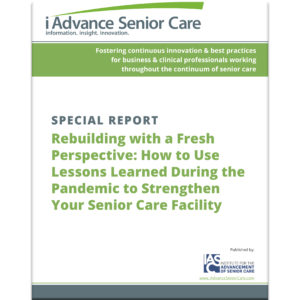Best practices for LTC facility emergency evacuation
A large number of devastating disasters, both natural and man-made, have struck North America within the past decade. After witnessing the destruction of facilities from these events and the evident lack of preparedness of some organizations, healthcare industry executives have had no other choice than to redefine their standards of emergency evacuation preparedness.
Several unfortunate tragedies in recent years have called attention to the necessity of emergency evacuation plans in long-term care (LTC) facilities. Here are a few specific examples of recent disasters involving hospitals or nursing homes:
- In January, a nursing home in Quebec caught fire, tragically leaving 30 out of 40 patients dead.
- In May 2011, St. John’s Mercy Hospital in Joplin, Mo., was utterly destroyed by a multiple-vortex EF5 tornado that devastated most of the city. In this case, emergency personnel and first responders were not available to provide assistance to those trapped in the hospital for 14 hours.
- In 2005, St. Rita’s Nursing Home in St. Bernard Parish, close to New Orleans, failed to evacuate patients before Hurricane Katrina, causing 35 patients to drown after being trapped in the facility.
These events were horrible tragedies that should inspire all facility managers to prepare for the worst-case scenario. Valuable lessons can be learned from examining past catastrophes, including the fact that facilities cannot simply rely on first responders or emergency personnel to arrive in time to safely evacuate everyone. LTC facilities must be self-reliant in the event of a full-scale or partial evacuation. This is a crucial aspect of evacuation planning that will make the difference between life and death for facility occupants. The following are four best practices to consider when developing or revising emergency evacuation plans.
1. PLAN
When preparing for an emergency evacuation, review and update any current evacuation plans. There is no better way to determine whether a facility is properly prepared for an evacuation than to thoroughly review facility plans and determine whether they will function properly during a worst-case scenario. This step is especially important when making plans for LTC facilities because of the frailty and immobility of the average resident. All facilities of this type must have the correct plans and proper equipment to conduct a safe, effective full-scale evacuation with a moment’s notice.
In addition to ensuring self-reliance in the event of an emergency, facility evacuation plans should address the absolute worst-case scenario, including loss of electricity and use of elevators as well as not having support from outside personnel. It is vital that plans address these scenarios.
2. SELECT PROPER EQUIPMENT
Automated facility equipment such as sprinkler suppression systems, which can be extremely useful in the event of a fire, only go so far in protecting residents during emergencies. When planning for an emergency evacuation, facility managers must assess the needs of the facility when it comes to safely evacuating each resident through obstacles such as stairwells and debris-filled hallways. A facility is not truly safe unless it is properly equipped, enabling the staff to get everyone out of the building in a safe and timely manner.
Depending on the type of facility, a wide array of evacuation equipment is available from which to choose. The most important aspect of selecting equipment, however, is ensuring that the product will meet the needs of staff and residents even in the worst of evacuation scenarios. Three basic categories of evacuation equipment are available: carry devices, wheeled devices (any device that uses wheels to facilitate the movement of a resident during an evacuation, including stair chairs, is considered a wheeled device) and evacuation sled devices.
3. TRAIN STAFF
Although training staff members for emergency evacuations is time-consuming, expensive and often not taken seriously, it can make a tremendous difference when a disaster strikes and residents must be evacuated. Review and update evacuation plans on an annual basis. Training for emergency evacuations also has been shown to reduce anxiety in staff members during emergencies. Facility managers should have a training system in place for new and existing staff members to ensure that evacuations will be carried out safely and efficiently, without confusion or panic.
4. CONDUCT DRILLS
Any training that staff members have received will not be fully retained until it is applied to real-world situations by conducting realistic evacuation drills. Research proves that consistent drills improve the memory of staff members and increase their ability to respond appropriately during an emergency event. Make drills as realistic as possible. Facility managers should attempt to create an environment that mirrors real-world emergencies by turning off the lights and shutting down elevators. This type of environment will truly prepare staff and residents to evacuate safely when necessary.
It is critical to develop a partnership with an equipment manufacturer with a shared commitment to evacuation preparedness. Manufacturers should be able to provide products, training and resources specially tailored to each facility. It is only by carefully reviewing each step of this process that healthcare professionals will truly prepare their facilities for an emergency evacuation.
Joe Pandolfo is president of ARC Products, LLC/Med Sled, which sells evacuation sled devices. For more information, call (866) 207-5993 or visit www.medsled.com.
Related Articles
Topics: Articles , Executive Leadership , Risk Management











